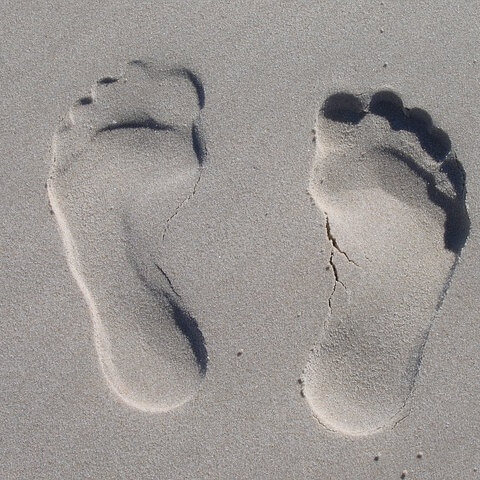
© Siam Pukato | shutterstock.com
Table of Contents
Subscribe to The Pain Relief Advisor
Sign up for our free newsletter & get expert pain management content delivered to your inbox every two weeks.
Subscribe now
Over 2.5 million people worldwide are using Liebscher & Bracht’s exercises to manage their pain themselves. Soon you’ll be one of them.
Sign up for our newsletter, The Pain Relief Advisor, and get expert pain management content delivered to your inbox every two weeks.
Just fill in the fields below and click “Subscribe.”
We Give You All the Important Information About Symptoms, Causes, Treatment Options and Exercises for Heel Spurs
Your heel hurts when you step on it, as if a nail is stuck in the sole of your foot? What you often find as the root cause of heel pain is a heel spur. Around ten percent of all Germans suffer from it at least once in their lives. But don’t worry! With the Liebscher & Bracht therapy, you can treat a heel spur yourself without surgery or medication. Because our vision is: “A painless life for everyone!”
And therefore, we are going to explain to you where your heel spur comes from, what really causes your complaints and how you can relieve your pain at home by yourself. So you are not helplessly at the mercy of the diagnosis “plantar fasciitis”!

Roland Liebscher-Bracht
Germany's most trusted pain specialist and author of several bestselling self-help books on the treatment of pain conditions.
Roland Liebscher-Bracht is Germany's most trusted pain specialist and author of several bestselling books on pain treatment. Together with his wife, Dr. med. Petra Bracht, he has developed a revolutionary method to treat pain conditions. With the help of the so-called "osteopressure", where you press specific points on your body, and special stretching exercises, pain can be stopped entirely without medication or surgical intervention. This pain treatment allows you to alleviate pain by yourself. Find out how exactly this works in this article or our numerous YouTube videos.
Roland Liebscher-Bracht
Germany's best-known pain specialist and author of several bestselling books on self-help against pain.
Roland Liebscher-Bracht is Germany's best-known pain specialist and author of several bestselling books on pain treatment. Together with his wife, the physician Dr. Petra Bracht, he has developed a revolutionary new form of pain treatment: With the so-called "Osteopressur", in which certain points on your body are pressed, and special stretching exercises, pain can be stopped completely without medication or surgical intervention. It is particularly important that this pain treatment gives you the opportunity to help yourself against your pain in a self-determined way. You can find out exactly how this works in this article and in the numerous YouTube videos.
1. Symptoms: How Does the Heel Spur Manifest Itself?
People with a heel spur often feel excruciating pain in their heel and can barely take a step. Often it feels as if a nail sticks in their foot with every step they take. In addition to a typical pressure pain, patients often describe a morning “start-walking pain” after getting up.1) This pain usually subsides during the day but comes back much stronger when your foot is under stress. (Hoberg, M./ Gradinger, R./ Rudert, M.; Fersenschmerz – was steckt dahinter?; In: MMW – Fortschritte der Medizin; 2007 (149), 24, S. 37)) In the case of heel pain, patients can no longer roll off or strain their feet properly and therefore go easy on it. Patients who (have to) stand a lot at work are particularly plagued by the deep, piercing pain in the rear sole of their foot.
1.1 What Is a Heel Spur?
A heel spur is a bony growth that forms on the heel bone (the calcaneus) and causes problems. Medically, a heel spur is called a calcaneal spur. Not every thorn-shaped bone growth also causes problems. However, patients with severe pressure pain in the heel bone are often diagnosed with “plantar fasciitis” which means: inflammation of the tendon in the sole of the foot. The so-called plantar fascia (also called plantar tendon) is a large tendon plate on the sole of the foot and extends from the heel bone to the metatarsophalangeal joints of the toes. Bony growths can occur at various points on the heel bone.

© Jarva Jar | shutterstock.com
The lower heel spur: If, for example, your foot drops, the tendon plate, which runs from the heel bone to your toes, is stretched by force and then too much. To relieve the tension and shorten your tendon, your foot forms a small bony calcaneal spur here. At this point one speaks of a so-called plantar heel spur.
The upper heel spur: But the tension on the tendon between the heel bone and the calf muscles, i.e. the Achilles tendon, can also be too great. Then the calcaneal spur tends to form at the top of the rear of the foot, more precisely at the attachment (enthesis) to the Achilles tendon. In this case one speaks of a dorsal heel spur.
1.2 How Is a Heel Spur Diagnosed?
Calluses or pressure sensitive areas can be determined by palpating your foot. Normally it is easy to feel the bony growths. In order to determine the exact extent and location, an x-ray is taken. (Gabel, E.; Fersenschmerz: So deuten Sie die Beschwerden richtig; In: Orthopädie & Rheuma; 2014 (1), 17))The heel is x-rayed laterally and axially. In the x-ray image, the bony spur is usually clearly visible and not hard to identify.

JOIN OVER 30,000 SUBSCRIBERS WHO ARE MANAGING THEIR PAIN THEMSELVES.
Sign up for The Pain Relief Advisor and each week we’ll deliver free expert pain management content right to your inbox.
All gain. No pain.
JOIN OVER 30,000 SUBSCRIBERS WHO ARE MANAGING THEIR PAIN THEMSELVES.

Sign up for The Pain Relief Advisor and each week we’ll deliver free expert pain management content right to your inbox.
All gain. No pain.
JOIN OVER 30,000 SUBSCRIBERS WHO ARE MANAGING THEIR PAIN THEMSELVES.

Sign up for The Pain Relief Advisor and each week we’ll deliver free expert pain management content right to your inbox.
All gain. No pain.
2. What Causes a Heel Spur?
The heel spur is your body’s answer to a lack of or repetitive movement.
In your daily life you typically walk in shoes and on level and smooth surfaces. You rarely experience any dips and bumps in the ground, as you would find on a beach or in a forest. In these situations, your foot would be challenged to adapt all the time. However, since we don’t find this kind of versatility in modern life, your foot easily forms a heel spur.
2.1 Liebscher & Bracht’s Explanation
Muscular-fascial tension causes the tendons connected to the heel to be under very high tension.
- If the tendon pulls too hard on the bone, the periosteum bulges a little at this point due to the negative pressure that is created.
- The bone understands this as a signal that it should grow there, because the tendon pulls it permanently in this direction.
- The space between the bones is filled and ossified – a heel spur is formed. And this can become really big.
The great misunderstanding of orthodox medicine is to believe that the heel spur itself causes your pain and discomfort. However, the heel spur is only a bony structure that has no pain receptors. The pain is registered by receptors in the surrounding tissue.
Pain-free with Liebscher & Bracht: Our goal is to take away your pain. How do you achieve this? We relax the muscles and fasciae around the heel spur to such an extent that the pull on the tendon is reduced and the pain receptors no longer sound the alarm. Your heel spur may not have disappeared, but it no longer hurts. At some point, your body can then decide to remove the heel spur. This happens within a few weeks or months. Or perhaps your heel spur will remain. As long as it does not cause any discomfort, it is not serious.
2.2 Development of a Heel Spur as Classical Orthodox Medicine Explains It
In Central Europe, heel spurs are the most common cause of pain in the heel region, accounting for almost 16 percent of all cases.2) About ten percent of all Germans also suffer from pain due to a heel spur once in their lives.3)
Conventional medicine claims a heel spur is caused by excessive or incorrect strain on the foot. The body tries to counteract the overload to create more stability. To do this, it deposits calcium at the tendon base and after some time a bony thorn develops there – a heel spur. The region around the heel spur becomes irritated and inflamed, which eventually causes the severe pain. Often the plantar tendon on the sole of the foot is irritated, but inflammation can also occur on the Achilles tendon.
Risk Factors for the Development of a Heel Spur:

Among the factors that in classical medicine foster the formation of a heel spur are: Flat feet, fallen arches and contracted feet, legs of uneven lengths, a shortened Achilles tendon, sudden weight gain, being overweight or training errors, such as rapid increase in running distance, speed or duration4) But different foot deformities can promote the formation of a heel spur as well.

Studies have shown that advanced age and an increased BMI (body mass index) are considered significant indicators of heel spurs.(Riepert, T./ Baltz, M./ Nafe, B./ Schweden, F./ Rittner, C.; Der plantare und dorsale Fersensporn als Hinweis auf höheres Lebensalter und erhöhten Bodymass-Index; In: Rechtsmedizin; 2002, 2, S. 100)) Overweight people are three times more likely to develop heel spurs than people with normal weight or lighter.5) Women are also more frequently affected than men. Heel spurs occur more frequently after the age of 50

JOIN OVER 30,000 SUBSCRIBERS WHO ARE MANAGING THEIR PAIN THEMSELVES.
Sign up for The Pain Relief Advisor and each week we’ll deliver free expert pain management content right to your inbox.
All gain. No pain.
JOIN OVER 30,000 SUBSCRIBERS WHO ARE MANAGING THEIR PAIN THEMSELVES.

Sign up for The Pain Relief Advisor and each week we’ll deliver free expert pain management content right to your inbox.
All gain. No pain.
JOIN OVER 30,000 SUBSCRIBERS WHO ARE MANAGING THEIR PAIN THEMSELVES.

Sign up for The Pain Relief Advisor and each week we’ll deliver free expert pain management content right to your inbox.
All gain. No pain.
3. Treatment: What Helps Against the Heel Spur?
3.1 Our Treatment
We at Liebscher & Bracht are convinced that with the help of our exercises you can self-manage your pain. Because our pain therapy gets to the root of the problem and does not just treat the symptoms. You can try out our exercises immediately. Our stretching exercises and fascial roller massages are aimed at neutralizing the excessive tension in the muscles and fascia around the heel spur. Then, finally, your pain can also disappear.
3.2 Treatment in Orthodox Medicine
Although orthodox medicine does not immediately resort to a surgical knife for a heel spur, many approaches, such as the use of insoles, only treat the symptoms and not the causes of heel spurs. These classic treatment options from orthodox medicine are explained in the following section. We will explain why these therapies will probably not be able to eliminate your complaints permanently.

Insoles: These soles are cut in such a way that there is a hole in the sole of the foot where the heel spur is located. This is called a hole insole. Thus, the heel spur hangs in the air, so to speak, and no longer causes problems or pain. In general, not all footwear is suitable for a heel spur. Shoes with a particularly soft sole are more comfortable for many patients. However, insoles only relieve the pain, and even that is not always the case. The cause of the spur remains.

Medication and injections: Doctors agree you have to get rid of the inflammation not the heel spur. The fastest way to do this is with a cortisone injection. But you should know that cortisone damages your tendons over time, so they might tear. Injuries can also occur if injections are too close to the tendon. So, in the long run the damage is greater than the gain. Therefore, it is better to try our exercises first.
Besides cortisone, other substances can also be used. Doctors from Greece and Switzerland have evaluated various studies on this. They found that “Botulinum toxin A” achieved significantly better results than cortisone.6) Patients thus have the chance of becoming pain-free within half a year.

Shock wave therapy: Treatment with shock wave therapy takes about 20 minutes.7) The patient lies on his back and the device is attached to the heel. A total of about 3800 shock waves are given per treatment.8) Examinations have shown an improvement of the morning start-up pain in the heel.(Buch, M./ Knorr, U./ Fleming, L./ Theodore, G./ Amendola, A./ Bachmann, C./ Zingas, C./ Siebert, W.E.; Extrakorporale Stoßwellentherapie beim symptomatischen Fersensporn – eine Übersicht; In: Orthopäde; 2002, 31 S.637)) With shock wave therapy, the pain receptors in the foot are triggered and thus immobilized. This therapy can at best alleviate the symptoms, i.e. the pain – but even that often does not work. With our exercises, on the other hand, we want to remove the cause of the pain.

Radiation therapy: There is the radiation option for your heel spur, like with cancer. The dose is very low. A study with more than 300 patients showed that after six months almost 86 percent of patients responded to the so-called megavolt radiation. About 75 percent of the patients had little or no pain after the treatment.9) Despite the success of the method, physicians disagree on the optimal dose of the therapy.10) You should also be concerned that you are voluntarily exposing your body to radiation.

Surgery: In the past, a heel spur was often operated on, but today many doctors advise against it. Orthopedist and foot surgeon Prof. Christina Stukenborg-Colsman explains that the operation has not helped many patients. In most cases the pain was still present even though the bony heel spur had been removed. In addition, it could be observed during the performed operations that in up to 50 percent of the cases a new heel spur is formed.11)

Physical therapy: Similar to our exercises, the goal here is to stretch the muscles and tendons on the sole of the foot. The exercises are usually guided by a physiotherapist and must then be continued independently by the patient at home. In Germany, however, physical therapy can only be prescribed by a doctor. You can try out our exercises yourself prescription-free.

With herbs against the pain: To reduce the inflammation around the heel spur in your foot, a new diet plan can help. For example, it can be useful to replace the inflammation-conducive fatty acid “arachidonic acid” in processed meat and sausage with good unsaturated fats. These include linseed oil, hemp oil or rapeseed oil. Herbs from the garden, such as mint, parsley or rosemary, contain natural anti-inflammatory substances. Studies show that 50 g nettles a day reduce inflammatory pain by more than half. To make them taste better, the nettles can be made into a smoothie with mango, for example. However, a change in diet is not enough, it is also important to get the right exercise. You can find out more about this in our exercise video.

JOIN OVER 30,000 SUBSCRIBERS WHO ARE MANAGING THEIR PAIN THEMSELVES.
Sign up for The Pain Relief Advisor and each week we’ll deliver free expert pain management content right to your inbox.
All gain. No pain.
JOIN OVER 30,000 SUBSCRIBERS WHO ARE MANAGING THEIR PAIN THEMSELVES.

Sign up for The Pain Relief Advisor and each week we’ll deliver free expert pain management content right to your inbox.
All gain. No pain.
JOIN OVER 30,000 SUBSCRIBERS WHO ARE MANAGING THEIR PAIN THEMSELVES.

Sign up for The Pain Relief Advisor and each week we’ll deliver free expert pain management content right to your inbox.
All gain. No pain.
4. These Exercises Can Help You with Heel Spur Problems
Our vision is a painless life for everyone — including you! Our exercises can help you to manage your heel spur pain. How do we achieve this?
We relax the muscles and fasciae around the heel spur so that the pull on the tendon is reduced and the pain receptors no longer sound the alarm.
In our exercise videos we show you different stretching exercises and additionally exercises with foam rollers. This will not make your heel spur disappear immediately, but it will hurt a lot less. It is possible that your body will remove the spur within a few weeks. Or perhaps your heel spur will remain. As long as it does not cause any discomfort, this is not a problem. You want to prevent a heel spur? Then, of course, you can take part in our exercises as a preventive measure!
At the beginning you should do our exercises six times a week and rest for one day. If the symptoms subside, you can do the exercises only three times a week. Do each exercise for two to two and a half minutes. All the exercises should give you stretching pain. This should always remain below a level of ten on your personal pain scale of one to ten. This means that if your breath can no longer flow freely, the stretching pain is too severe and you should not lean so deeply into the stretch.

Exercise 1: Stretch Your Calf
- Position yourself at a small distance from the wall.
- Support yourself with your hands on the wall, place one foot forward and the foot with the heel spur backward.
- Make sure that your back leg is stretched out and that your heel is flat on the floor.
- Then turn your leg and foot until you have found the spot where it pulls the most.
- Now you can bend the knee of your back leg a little bit and immediately feel a more intense stretch in your calf and sole.
- Lean more and more into the exercise for two to two and a half minutes.

Exercise 2: Stretch the Sole of Your Foot
- Sit down on an exercise mat and stretch your legs.
- Then pull up your leg with the heel spur a little bit.
- Hold your toes with your hands and pull the toes towards your body. This stretches the muscles, plantar tendon and fascia all over the sole of your foot.
- This exercise should also be held for two to two and a half minutes, and the stretching should become more intense.

Exercise 3: Fascial Roller Massage with the Mini Foam Roll
- Stand up and grab a mini foam roller.
- Place the mini foam roller on your mat and put the ball of your foot on the roller.
- Now roll slowly towards the heel.
- After a short time, your toes might touch the front of the mat. As soon as this happens, you can pull yourself forward by your toes.
- Roll along the entire sole of the foot to the end of the heel bone.
- You should still be able to breathe calmly during the exercise, but still roll right over the painful areas.

Exercise 4: Fascial Roller Massage with the Mini Foam Ball
- Sit on your mat and take a mini foam ball.
- Now you place the mini ball exactly on the spots that cause pain.
- You should build up as much pressure as possible, but still be able to breathe freely.
- Now roll on the painful areas with small spiral movements. Regular use will make you feel better!
📌 Checklist for Liebscher & Bracht Exercises
To make sure nothing goes wrong with our exercises, we have put together seven important tips. They should help you to easily integrate the exercises into your daily life and achieve optimal results.
✅ Practice six days a week and do each exercise at least once a day.
✅ For each exercise you should invest two to two and a half minutes. If you are just starting to do the exercises or if the pain is still too much, you can also gradually increase the intensity. Remember, however, that stretching for only a few seconds has little or no effect.
✅ Always use your personal pain scale of one to ten as a guide. The best results are achieved if you work on a scale of eight or nine for each stretch. Nine means: You feel an intense pain but can still breathe calmly and do not have to muscled-guard.
✅ A pain that is still bearable is the most important point of reference for you. So, don’t be afraid of it: Your body will tell you that you are counteracting the muscular “contractions” in exactly the right place.
✅ Be patient – even if it is difficult. It may take some time for your brain to store new movement programs. But if you stay on the ball and make the exercises your daily routine, you can regain your freedom from pain.
✅ Use professional aids and not cheap products to treat your pain. If you rely on a defective product here, this can have a negative effect. We have therefore taken great care in the development of our aids and developed them especially for pain treatment.
✅ If the pain increases due to the exercises, there is no reason to panic. That things get worse initially can be a normal reaction of your body. If your overall body statics change as a result of regular exercise, the musculoskeletal system will have to adapt to this gradually. If, however, you feel worse all the time instead of better after the exercises, your body signals that you may be overdoing it. Then simply take a break for a day or two and/or reduce the intensity a little bit during your next training sessions in order to increase it again in small steps. In this way, you gently guide your body to the eight or nine on the pain scale that is right for you.

JOIN OVER 30,000 SUBSCRIBERS WHO ARE MANAGING THEIR PAIN THEMSELVES.
Sign up for The Pain Relief Advisor and each week we’ll deliver free expert pain management content right to your inbox.
All gain. No pain.
JOIN OVER 30,000 SUBSCRIBERS WHO ARE MANAGING THEIR PAIN THEMSELVES.

Sign up for The Pain Relief Advisor and each week we’ll deliver free expert pain management content right to your inbox.
All gain. No pain.
JOIN OVER 30,000 SUBSCRIBERS WHO ARE MANAGING THEIR PAIN THEMSELVES.

Sign up for The Pain Relief Advisor and each week we’ll deliver free expert pain management content right to your inbox.
All gain. No pain.
Sources & Studies
- ↑1 Buch, M./ Knorr, U./ Fleming, L./ Theodore, G./ Amendola, A./ Bachmann, C./ Zingas, C./ Siebert, W.E.; Extrakorporale Stoßwellentherapie beim symptomatischen Fersensporn - eine Übersicht; In: Orthopäde; 2002, 31, S. 637
- ↑2 Heyd, R./ Tselis, N./ Ackermann, H./ Röddiger, S./ Zamboglou, N.; Funktionelle Ergebnisse nach Megavoltbestrahlung beim Fersensporn; In: Strahlenther Onkol; 2006, 12, S. 734
- ↑3 Oberhofer, E.; Fersensporn: wenn Injektionstherapie, dann am ehesten Botulinumtoxin; In: Orthopädie & Rheuma, 2016 (4), 19, S. 12
- ↑4 Buch, M./ Knorr, U./ Fleming, L./ Theodore, G./ Amendola, A./ Bachmann, C./ Zingas, C./ Siebert, W.E.; Extrakorporale Stoßwellentherapie beim symptomatischen Fersensporn - eine Übersicht; In: Orthopäde; 2002, 31, S. 638
- ↑5 Riepert, T./ Baltz, M./ Nafe, B./ Schweden, F./ Rittner, C.; Der plantare und dorsale Fersensporn als Hinweis auf höheres Lebensalter und erhöhten Bodymass-Index; In: Rechtsmedizin; 2002, 2, S. 101
- ↑6 Oberhofer, Elke; Fersensporn: wenn Injektionstherapie, dann am ehesten Botulinumtoxin; In: Orthopädie & Rheuma, 2016 (4), 19 S.12
- ↑7 Buch, M./ Knorr, U./ Fleming, L./ Theodore, G./ Amendola, A./ Bachmann, C./ Zingas, C./ Siebert, W.E.; Extrakorporale Stoßwellentherapie beim symptomatischen Fersensporn - eine Übersicht; In: Orthopäde; 2002, 31 S.641
- ↑8 Buch, M./ Knorr, U./ Fleming, L./ Theodore, G./ Amendola, A./ Bachmann, C./ Zingas, C./ Siebert, W.E.; Extrakorporale Stoßwellentherapie beim symptomatischen Fersensporn - eine Übersicht; In: Orthopäde; 2002, 31 S.640
- ↑9 Heyd, R./ Tselis, N./ Ackermann, H./ Röddiger, S./ Zamboglou, N.; Funktionelle Ergebnisse nach Megavoltbestrahlung beim Fersensporn; In: Strahlenther Onkol; 2006, 12 S.733
- ↑10 Heyd, R./ Tselis, N./ Ackermann, H./ Röddiger, S./ Zamboglou, N.; Funktionelle Ergebnisse nach Megavoltbestrahlung beim Fersensporn; In: Strahlenther Onkol; 2006, 12 S.737
- ↑11 Heyd, R./ Tselis, N./ Ackermann, H./ Röddiger, S./ Zamboglou, N.; Funktionelle Ergebnisse nach Megavoltbestrahlung beim Fersensporn; In: Strahlenther Onkol; 2006, 12 S.734
